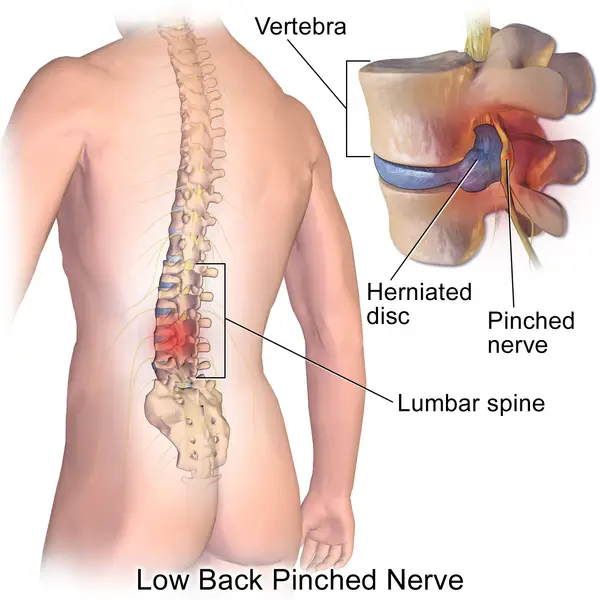If you’re looking for a way to relieve your pinched nerve pain, you may be wondering if an inversion table is a good option. Inversion therapy can be beneficial for some people, but it’s not right for everyone. Here’s what you need to know about using an inversion table for a pinched nerve.
Contents
What is a Pinched Nerve?
A pinched nerve happens when too much pressure is applied to a nerve by surrounding tissues, such as bones, cartilage, muscles, or tendons. This pressure disrupts proper nerve function and causes pain, tingling, numbness, or weakness.
Pinched nerves can occur in many areas of the body, but they’re especially common in the wrists (carpal tunnel syndrome), neck (herniated disk), and lower spine (nerve root compression).
Most pinched nerves can be treated with conservative measures, such as rest, ice/cold therapy, heat therapy, and stretching exercises. In some cases, however, you may need medication or surgery to relieve the pressure on the nerve.

What Are the Symptoms of a Pinched Nerve?
There are a few different signs that may point to a pinched nerve. The first and most frequent feeling is numbness and pain in the affected area. Many times, this is accompanied by an outward tingling sensation in the extremities.
In more severe cases, muscle weakness may make it difficult to move the affected limb. The needles sensations are also common with a pinched nerve. As the name suggests, it feels as if there are needles poking the affected area. This is usually accompanied by a decreased sensation in the area as well.
What Causes a Pinched Nerve?
There are many possible causes of a pinched nerve, including:
- Swelling of the tissues around the nerve, such as in the case of a swollen tendon sheath
- Sports activities that put repeated stress on the nerve, such as tennis or golf
- Obesity, which can cause extra pressure on the nerve
- Permanent nerve damage from an injury or disease
- Repetitive work or hobbies that require constant use of the affected area, such as typing or knitting
- Carpal tunnel syndrome, is a condition caused by pressure on the nerves in your wrist
- A herniated spinal disk occurs when part of the disk bulges out and puts pressure on the nerves
In most cases, rest and home treatment will relieve your symptoms and help you recover. However, in some cases, a pinched nerve can lead to permanent damage. If you experience any loss of feeling or muscle weakness, you should see your doctor right away. In most cases, however, nerve function returns once the pressure is relieved.
What Are the Risk Factors?
There are several risk factors that may contribute to the development of carpal tunnel syndrome.
These include:
- Nerve compression: This can be caused by conditions such as rheumatoid arthritis, bone spurs, or tumors.
- Thyroid disease: This can lead to enlargement of the tissues in the carpal tunnel, which puts pressure on the median nerve.
- Prolonged bed rest: This can cause the muscles and tissues in the wrist to become weak and put pressure on the median nerve.
- Smaller carpal tunnels: People with smaller than average carpal tunnels are at a higher risk for developing symptoms.
How to Prevent a Pinched Nerve?
If you want to prevent a pinched nerve, you should:
- Stay in good physical condition by following a regular exercise program.
- Avoid repetitive activities that put a strain on the nerve.
- Take frequent breaks and change your position often when engaging in activities that put a strain on the nerve.
- Make sure that your workstation is set up in a way that promotes good positioning and posture.
- Maintain a healthy weight to reduce the amount of strain on your body.
- Do flexibility exercises to keep your muscles and joints supple.
How To Use Inversion Therapy To Relieve a Pinched Nerve
If you have a pinched nerve, you may be wondering if an inversion table can help relieve your pain. Inversion therapy is a type of treatment that involves hanging upside down or at an angle to stretch the spine and decompress the disks. This can take pressure off of the nerves and provide relief.
Before you try inversion therapy, it’s important to consult with your doctor to make sure it’s safe for you. If you have a serious medical condition, such as heart disease, hypertension, glaucoma, or osteoporosis, inversion therapy may not be right for you.
Once you’ve consulted with your doctor and gotten the green light to try inversion therapy, there are a few basic safety standards to follow. First, make sure you purchase a quality inversion table from a reputable company.
We recommend Teeter Inversion Tables because they meet all of the safety standards set by UL (Underwriters Laboratories).
Next, read the instruction manual that comes with your table thoroughly before using it. And finally, start slowly by inverting for just a short period of time (1-2 minutes) and progress from there as your body adjusts.
In general, people with pinched nerves report good results from using inversion tables. However, keep in mind that inversion therapy is not a cure-all and it may not provide relief for everyone. If you do not see any improvement after several weeks of treatment, consult with your doctor to see if another course of action is recommended.
How To Relieve Pinched Nerve Symptoms with Teeter Inversion Tables
There are many ways Teeter can help relieve pinched nerve symptoms and help you feel better. Inverted traction with a Teeter inversion table or inversion chair decompresses the spine, taking pressure off of nerves. This can provide immediate pain relief as well as long-term healing.
The benefits of inverting also include:
- Stretching the muscles and ligaments surrounding the spine
- Giving discs a chance to rehydrate and absorb nutrients
- Improving circulation throughout the body
- Helping to reduce inflammation
If you’re looking for back pain relief, Teeter has you covered with a variety of inversion products and accessories designed to help you feel better fast. Visit our Inversion Page to learn more about how inverting can help relieve pinched nerve symptoms and other forms of back pain.
Frequently Asked Questions
Can an inversion table fix a pinched nerve?
An inversion table may help to provide relief from a pinched nerve by stretching and decompressing the spine. This may help to take pressure off of the nerve and allow it to heal.
Will an inversion table help a pinched sciatic nerve?
An inversion table may help to temporarily relieve the symptoms of a pinched sciatic nerve, but it is not a cure. Inversion therapy may help to stretch and decompress the spine, which may help to relieve pressure on the sciatic nerve.
How do I know if my pinched nerve is healing?
The most obvious way to tell if a pinched nerve is healing is through the recovery of muscle function and movement. Another way to tell if a pinched nerve is healing is if there is a decrease in pain and swelling in the affected area.
inversion table, inversion tables, inversion therapy, neck pain, cervical radiculopathy, slipped discs, herniated discs, physical therapy, spinal discs, table treatment, blood pressure, new inversion table, physical therapist, side straps, light level, gravitational pressure, good idea, bare feet, back muscles, back area, lumbar support, single level lumbar, herniated disc, solid solution, soft centers, uncomfortable symptoms, side effects, inversion table treatment, mayo clinic, slipped disc, lower back pain, chronic back pain, spinal discs, degenerative disc disease, herniated, bulging disc, herniated disk, lower back, chiropractor, disc herniation, back pain, vertebrae, spinal
Conclusion
Yes, the inversion table is good for pinched nerves and degenerative disc disease if you use it correctly and moderately. It is important to note that this is a treatment option and not a cure. In other words, inversion therapy will not fix the underlying cause of your pinched nerve. However, it can provide significant relief from the pain and other symptoms associated with this condition.
Inversion therapy has been shown to be effective in reducing neck pain, sciatica, and headaches. It is also thought to be helpful in treating herniated discs and spinal stenosis. In addition, inversion therapy can help improve your posture and flexibility.
If you are considering inversion therapy for your pinched nerve, it is important to consult with your doctor first. This is especially true if you have any pre-existing medical conditions or if you are pregnant. Once you have been cleared for inversion therapy, be sure to start slowly and increase the amount of time you spend inverted gradually.

Dave Lee is the founder of Spine Institute NY, a huge fan of inversion therapy, a researcher, and an author.

